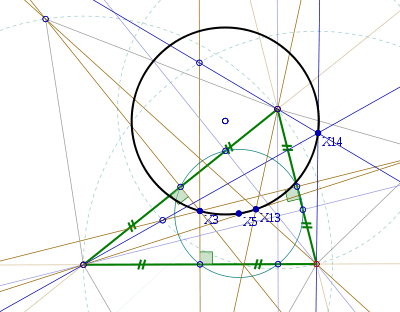Lester's theorem

The Fermat points , the center of the nine-point circle (light blue), and the circumcenter of the green triangle lie on the Lester circle (black).
In Euclidean plane geometry, Lester's theorem states that in any scalene triangle, the two Fermat points, the nine-point center, and the circumcenter lie on the same circle. The result is named after June Lester, who published it in 1997,[1] and the circle through these points was called the Lester circle by Clark Kimberling.[2] Lester proved the result by using the properties of complex numbers; subsequent authors have given elementary proofs[3][4][5][6], proofs using vector arithmetic,[7] and computerized proofs.[8]
See also
References
- ↑ Lester, June A. (1997), "Triangles. III. Complex triangle functions", Aequationes Mathematicae, 53 (1-2): 4–35, MR 1436263, doi:10.1007/BF02215963
- ↑ Kimberling, Clark (1996), "Lester circle", The Mathematics Teacher, 89 (1): 26, JSTOR 27969621
- ↑ Shail, Ron (2001), "A proof of Lester's theorem", The Mathematical Gazette, 85 (503): 226, doi:10.2307/3622007
- ↑ Rigby, John (2003), "A simple proof of Lester's theorem", The Mathematical Gazette, 87 (510): 444–452, JSTOR 3621279, doi:10.1017/S0025557200173620
- ↑ Scott, J. A. (2003), "Two more proofs of Lester's theorem", The Mathematical Gazette, 87 (510): 553–566, JSTOR 3621308
- ↑ Duff, Michael (2005), "A short projective proof of Lester's theorem", The Mathematical Gazette, 89 (516): 505–506, doi:10.1017/S0025557200178581
- ↑ Dolan, Stan (2007), "Man versus computer", The Mathematical Gazette, 91 (522): 469–480, JSTOR 40378420, doi:10.1017/S0025557200182117
- ↑ Trott, Michael (1997), "Applying GroebnerBasis to three problems in geometry", Mathematica in Education and Research, 6 (1): 15–28
External links
This article is issued from
Wikipedia.
The text is licensed under Creative Commons - Attribution - Sharealike.
Additional terms may apply for the media files.